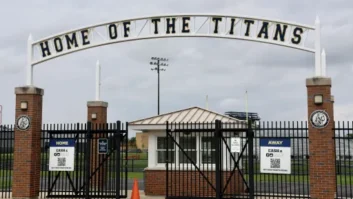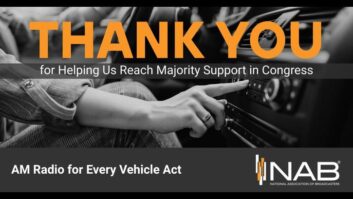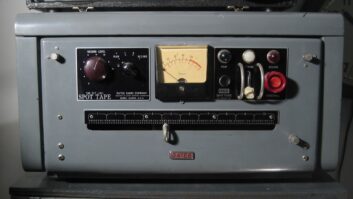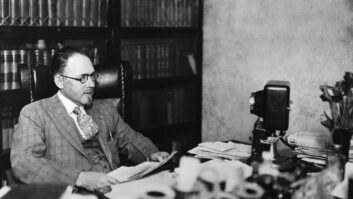The idea of making Daylight Saving Time a permanent fixture has been broadly discussed before but when the U.S. Senate adopted a bill to make it the law of the land recently, broadcast industry representatives quickly jumped up to protest.
The aptly named Sunshine Protection Act would extend Daylight Saving Time in the United States year-round but could have damaging programming and technical implications for many AM broadcasters. The outlook for the legislation in the U.S. House was unclear as of early April.
For 80 years most Americans have observed the tradition of resetting their clocks spring and fall. Reverting to Standard Time during winter months has benefitted AM broadcasters operating only during daylight hours and those with restricted nighttime coverage. The time shift allows earlier sign-on and full-power operating times.
However, a change to extend DST would impact the critical AM morning drive time on those stations and potentially hurt revenue generated by morning shows. Those stations would benefit from later sign-off times in November, December, January and February, but not enough to offset getting short changed on morning drive, according to some AM owners (see sidebar).
The FCC declined comment on the legislation and would not speculate on how it could affect U.S. AM broadcasters. The commission has spent the past decade touting its AM revitalization measures to save the senior band.
The National Association of Broadcasters said it was working with the bill’s authors and the leadership of the House Energy and Commerce Committee to minimize potential impact on broadcasters.
Final blow?
Ben Downs, vice president and general manager of Bryan Broadcasting, which operates four AM stations, said the harm from a switch to year-round DST would go beyond daytimers. He estimates that over 75% of AM radio stations would be affected.
“All but about 1,000 of the 4,500 or so licensed AM stations either sign on, increase power or go to a less restrictive directional pattern at sunrise,” Downs said. “AM radio comes alive at sunrise.”
The band is already “living in a sea of noise and interference from digital devices and their inexpensive power supplies,” Downs said; he thinks permanent Daylight Saving Time would be the final blow for many small-market AM stations.
“As we all know, most small-market AM stations do not operate with large profit margins. The sun rising brings AM radio to life for most. In the winter, listeners would find these stations — their news, information, entertainment and advertisements — would not even exist,” Downs said.
[See Our Business and Law Page]
KTBB(AM) at 600 kHz and licensed to Tyler, Texas, is another of the stations that would be hurt by year-round DST. The station, 5,000 watts by day and 2,500 watts at night, would lose approximately 40% of its Nielsen-defined metro between local sunset and local sunrise, according to Paul Gleiser, its president and owner.
“For about a four-month period, 40% of the market would not be able to hear it until after 8 a.m., and possibly as late at 8:30 a.m. That would effectively end KTBB’s viability,” Gleiser said. “A station that can’t be heard very well before 8 a.m. has very limited revenue prospects.”
Gleiser says he is fortunate to be able to simulcast programming on an FM that he purchased in 2015, one that covers the full market. “For operators of AM stations without such an alternative, 12-month DST is potentially fatal.”
And Gleiser said he wouldn’t expect the FCC to step in with an across-the-board modification of operating hours to help AM broadcasters affected if Daylight Saving Time is in effect year around.
“If, for example, the FCC permitted power increases at 6 a.m. rather than waiting for local sunrise, the resulting interference would be a major problem. I would expect zero help from the FCC,” he said.
“Very concerned”
Randy Miller, president of Miller Media Group, owns two daytime AM stations with no pre-sunrise or post-sunset authority. WHOW(AM) is licensed to Clinton, Ill., while (WTIM) is 500 watts and licensed to Assumption/Taylorville, Ill. They serve critical roles in the community, Miller said.
“I am very concerned about this. Our expanded local newscasts air in each market at 7:10 a.m., which means they won’t be heard. When severe weather, i.e. snow and ice hits, parents and children will not be getting any of the school closings we’ll be broadcasting in the morning during the winter.”
His AMs are paired with several FM translators but he worries about older members of the community that rely on the AM signal to monitor programming.
“Finally, our local advertisers will miss an opportunity to reach their potential customers during the morning, due to the 8:15 a.m. sign-on,” Miller said.
[Related: “Rotella Raises Daylight Saving Concerns With Pallone”]
The Sunshine Protection Act, sponsored by Sen. Marco Rubio, R-Fla., would especially hurt stations in the northern half of the U.S., said Steve Moravec, president of Phoenix Media Group Inc.
“Senator Rubio represents a state with some of the southernmost real estate in the country. For the northern half of the United States, the measure would create yet another problem for AM owners to overcome,” he said.
Moravec, a former AM radio station owner who now concentrates on consulting and brokerage activities, says restricting or changing daytime coverage or full-power hours makes a mockery of AM service to the listening public and threatens the AM band’s long-term viability.
“It’s hard to sell morning drive at a premium if the audience can’t hear the radio station,” Moravec said. “Just imagine a heavy spot load during the holiday season and you can’t go to full facilities until perhaps 9 a.m.”
There also would be the added burden of Canada and Mexico needing to concur with any U.S. action, he says.
Veteran news and talk radio consultant Holland Cooke said many of his AM clientele have already essentially evacuated the band for the safety of FM through the use of translators.
“The smart ones are already pretending to be FM by rebranding themselves. Because AM is just so challenged, and this possible switch to year-round Daylight Saving Time will do none of them any good. To think you can successfully operate an AM station being invisible during most of morning drive is ludicrous,” Cooke said.
Another AM radio advocate notes that translators generally are not available in larger markets, where the FM band is nearly full. There, AM operators cannot allocate an FM translator of any size due to spacing and interference requirements.
“A 250 watt translator is a rarity in large markets, with some translator operators operating with as little as one watt in order to conform to interference requirements. This leaves many AM stations in major markets without an FM simulcast as backup,” he said.
Daylight Saving Time was implemented in 1916 in an effort to conserve fuel during World War I. Under the proposed law, the country would have until Nov. 20, 2023, to prepare for the change.
Unpredictability of nighttime AM
Thousands of AM stations, many of them Class D stations, are required by the FCC’s rules to reduce their power, use a more restrictive coverage pattern, or cease operating at night to avoid interference to other AM stations. Local sunrise and sunset times therefore are critical to thousands of AM broadcasters in the United States.
There are 1,965 Class D AM stations in the United States. Of those, 1,011 operate daytime only, according to the FCC.
Industry observers say that in the lower 48 states, AM operators in major cities across the Pacific Northwest would be especially sensitive to a shift to permanent Daylight Saving Time, given their northerly locations. For example, Portland, Ore., is farther north than Minneapolis.
Some Class D stations operate with presunrise authorization and postsunset authorization during some months with special authorization from the FCC, according to the commission. However, the rule is complicated, industry experts say, and because of a lack of suitable software, the commission has not granted new PSRA and PSSA authorizations for several years.
A flip to permanent Daylight Saving Time would bring operating complications for AM broadcasters, said Ben Dawson, consulting engineer with Hatfield & Dawson, since the propagation mechanism for frequencies of the AM band is different between daytime and nighttime.
“The groundwave propagation that provides service during daylight hours is quite consistent, but the nighttime propagation mechanism that produces skywave coverage and interference is not. And it varies seasonally and during the nighttime hours,” Dawson said.
A change to full-time DST — essentially moving the entire country one time zone east — won’t reduce daytime operation hours but would cause morning power change or sign-on times to be an hour later in the winter, Dawson said.
Randy J. Stine has spent the past 40 years working in audio production and broadcast radio news. He joined Radio World in 1997 and covers new technology and regulatory issues. He has a B.A. in journalism from Michigan State University.







